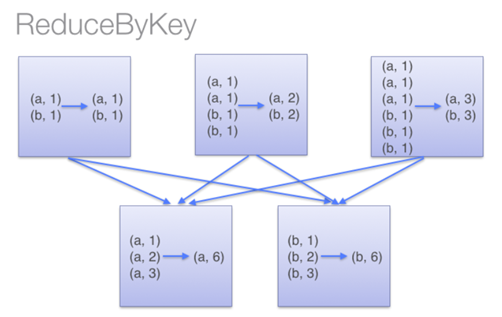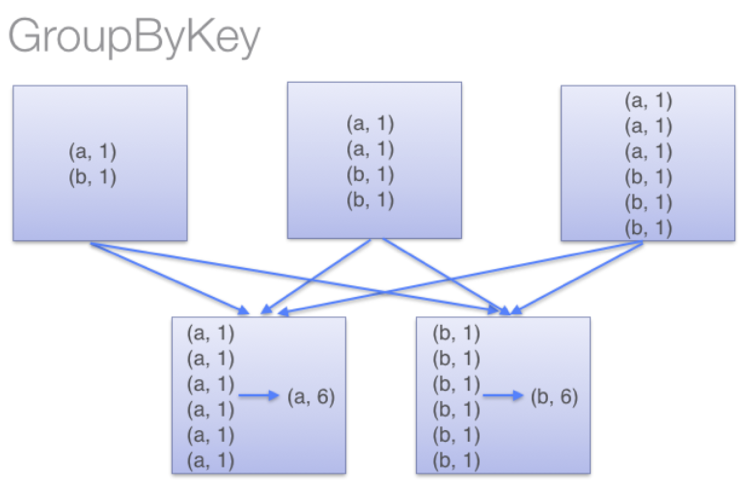避免使用GroupByKey
我们看一下两种计算word counts 的方法,一个使用reduceByKey,另一个使用 groupByKey:
val words = Array("one", "two", "two", "three", "three", "three")
val wordPairsRDD = sc.parallelize(words).map(word => (word, 1))
val wordCountsWithReduce = wordPairsRDD
.reduceByKey(_ + _)
.collect()
val wordCountsWithGroup = wordPairsRDD
.groupByKey()
.map(t => (t._1, t._2.sum))
.collect()
以上两个函数都会产生正确的结果,reduceByKey的例子在大型数据集上工作的效率会更高。因为Spark知道:在shuffle data之前,它可以根据key, 在每个partition上,对输出数据在本地做combine。
下图描述了reduceByKey的执行过程。值得注意的是,在shuffle 数据之前,同一个机器上具有相同key的item会先在本地combine(使用的combine函数是传递给reduceByKey的lambda 函数)。然后这个lambda 函数会再次在执行shuffle后的每个分区上被调用,以产生最终的结果。

而在groupByKey中,所有的key-value对被先shuffle到下游RDD分区中。这会导致很多不必要的网络数据传输。
在决定将一个key-value对shuffle到哪个机器上时,spark会key-value对中的key调用一个partitioning 函数,以决定分到的目标机器。在shuffle时,若是shuffle的数据(由于内存大小限制)无法全部放入到一个executor中,则Spark会将数据spill到disk。但是,在flush数据到disk时,一次只flush一个key(对应的key-value pairs 数据):所以如果单个key对应的key-value pairs 数据超出了executor可用的memory,则会抛出OOM异常。在较新版的Spark中会处理此异常并让job可以继续执行,但是仍需要尽量避免此类现象:当spark需要spill到磁盘时,spark性能会受到显著影响。

所以在非常大的数据集上计算时,对于reduceByKey与groupByKey来说,它们所需要传输的shuffle数据是有显著不同的。
而在小型数据集上进行测试时(仍使用word count的例子),从测试结果来看,groupByKey的表现要优于reduceByKey。抛开shuffle阶段来看,reduceByKey对内存率会更高于groupByKey,所以相对会报出更多内存不足的情况。若是需要使用reduceByKey,则需要给executor 更多内存在本地做计算。
相对于groupByKey,除了reduceByKey,下面的函数也会是更好的选择:
- combineByKey:可以用于combine元素,用于返回与输入类型不同类型的值
- foldByKey:初始化一个“zero value”,然后对每个Key的值做聚合操作
接下来详细介绍一下这两个函数。
combineByKey
我们先看一下combineByKey的定义:
def combineByKey[C](
createCombiner: V => C,
mergeValue: (C, V) => C,
mergeCombiners: (C, C) => C): RDD[(K, C)] = self.withScope {
combineByKeyWithClassTag(createCombiner, mergeValue, mergeCombiners)(null)
}
可以看到此方法调用的是 combineByKeyWithClassTag:
def combineByKeyWithClassTag[C](
createCombiner: V => C,
mergeValue: (C, V) => C,
mergeCombiners: (C, C) => C)(implicit ct: ClassTag[C]): RDD[(K, C)] = self.withScope {
combineByKeyWithClassTag(createCombiner, mergeValue, mergeCombiners, defaultPartitioner(self))
}
继续查看下一层调用:
def combineByKeyWithClassTag[C](
createCombiner: V => C,
mergeValue: (C, V) => C,
mergeCombiners: (C, C) => C,
partitioner: Partitioner,
mapSideCombine: Boolean = true,
serializer: Serializer = null)(implicit ct: ClassTag[C]): RDD[(K, C)]
查看reduceByKey代码,可以发现它最终调用的也是combineByKeyWithClassTag 方法:
def reduceByKey(partitioner: Partitioner, func: (V, V) => V): RDD[(K, V)] = self.withScope {
combineByKeyWithClassTag[V]((v: V) => v, func, func, partitioner)
}
从combineByKeyWithClassTag方法定义来看,第一个参数是提供用户自定义的类型,用于将输入的<K,V> 中的 V 转化为用户指定类型,第二个参数用于merge V 的值到 C(用户定义类型),第三个参数用于将 C 的值 combine 为一个单值。这里可以看到默认是会在map端做combine,所以默认combineByKey与reduceByKey都是会在map端先做combine操作。
但是对于 groupByKey来说:
def groupByKey(partitioner: Partitioner): RDD[(K, Iterable[V])] = self.withScope {
// groupByKey shouldn't use map side combine because map side combine does not
// reduce the amount of data shuffled and requires all map side data be inserted
// into a hash table, leading to more objects in the old gen.
val createCombiner = (v: V) => CompactBuffer(v)
val mergeValue = (buf: CompactBuffer[V], v: V) => buf += v
val mergeCombiners = (c1: CompactBuffer[V], c2: CompactBuffer[V]) => c1 ++= c2
val bufs = combineByKeyWithClassTag[CompactBuffer[V]](
createCombiner, mergeValue, mergeCombiners, partitioner, mapSideCombine = false)
bufs.asInstanceOf[RDD[(K, Iterable[V])]]
}
可以看到,groupByKey虽然最终调用的也是combineByKeyWithClassTag 方法,但是并不会在map端执行Combine操作(mapSideCombine为false)。
下面我们写一个combineByKey求解平均数的例子:
type ScoreCollector = (Int, Double) type PersonScores = (String, (Int, Double))
val initialScores = Array(("Alice", 90.0), ("Bob", 100.0), ("Tom", 93.0), ("Alice", 95.0), ("Bob", 70.0), ("Jack", 98.0)) val scoreData = sc.parallelize(initialScores).cache() val createScoreCombiner = (score: Double) => (1, score)
val scoreMerge = (scorecollector: ScoreCollector, score: Double) => (scorecollector._1 +1, scorecollector._2 + score) val scoreCombine = (scorecollector1: ScoreCollector, scorecollector2: ScoreCollector) => (scorecollector1._1 + scorecollector2._1, scorecollector1._2 + scorecollector2._2) scoreData.combineByKey( createScoreCombiner, scoreMerge, scoreCombine ).map( {pscore: PersonScores => (pscore._1, pscore._2._2 / pscore._2._1)}).collect
输出为: Array[(String, Double)] = Array((Tom,93.0), (Alice,92.5), (Bob,85.0), (Jack,98.0))
可以看到,首先原类型为(String, Double),然后我们通过combineByKey的第一个参数,将其转化为(Int, Double) 形式,用于统计次数与分数。接下来第二个参数用于merge,将同样key条目出现的次数、以及分数相加。最后第三个参数用于做combine,对每个key,求得的分数求总和,然后除以次数,求得平均值。
这里可以看出 combineByKey与reduceByKey的区别是:combineByKey的可以返回与输入数据类型不一样的输出。
foldByKey
foldByKey 是初始化一个“zero value“,然后对key的value值做聚合操作。例如:
val initialScores = Array(("Alice", 90.0), ("Bob", 100.0), ("Tom", 93.0), ("Alice", 95.0), ("Bob", 70.0), ("Jack", 98.0))
val scoreData = sc.parallelize(initialScores).cache()
scoreData.foldByKey(0)(_+_).collect
输出为: Array[(String, Double)] = Array((Tom,93.0), (Alice,185.0), (Bob,170.0), (Jack,98.0))
可以看到,这里给出的“zero value“为0,在执行计算时,会先将所有key的value值与”zero value“做一次加法操作(由_+_定义),然后再对所有key-pair做加法操作。所以若是此时使用:
scoreData.foldByKey(1)(_+_).collect
则输出为:Array[(String, Double)] = Array((Tom,94.0), (Alice,187.0), (Bob,172.0), (Jack,99.0))
下面是 foldByKey的源码:
def foldByKey(
zeroValue: V,
partitioner: Partitioner)(func: (V, V) => V): RDD[(K, V)] = self.withScope {
// Serialize the zero value to a byte array so that we can get a new clone of it on each key
val zeroBuffer = SparkEnv.get.serializer.newInstance().serialize(zeroValue)
val zeroArray = new Array[Byte](zeroBuffer.limit)
zeroBuffer.get(zeroArray)
// When deserializing, use a lazy val to create just one instance of the serializer per task
lazy val cachedSerializer = SparkEnv.get.serializer.newInstance()
val createZero = () => cachedSerializer.deserialize[V](ByteBuffer.wrap(zeroArray))
val cleanedFunc = self.context.clean(func)
combineByKeyWithClassTag[V]((v: V) => cleanedFunc(createZero(), v),
cleanedFunc, cleanedFunc, partitioner)
}
可以看到它与reduceByKey和combineByKye类似,最终调用的也是combineByKeyWithClassTag 方法,且未覆盖mapSideCombine 的值,所以默认也会在map端进行combine操作。
所以在大型数据集中,为了减少shuffle的数据量,相对于groupByKey来说,使用reduceByKey、combineByKey以及foldByKey 会是更好的选择。
References: